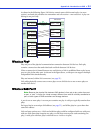
Appendix A: Introduction to SAS ● 55
What’s a SAS Address?
Each SAS port is identified with a unique SAS address, which is shared by all phys on that port.
For example, a SAS disk drive might have two narrow ports. Each port has one unique SAS
address. The single phy in each port uses its port’s SAS address.
In another example, a SAS device might have one 4-wide port. That port has one SAS address,
which is shared by all four phys in the port.
Unlike SCSI devices and SCSI IDs, SAS devices self-configure their SAS addresses. User
intervention is not required to set SAS addresses, and SAS addresses cannot be modified.
What’s a SAS Connector?
A SAS connector is the physical plug or receptacle that you see on a SAS device. It supports the
power and signal line cable. It’s what you plug a SAS cable into, or the end of the SAS cable
that’s being plugged in.
A connector is what forms physical links between phys. Some SAS connectors can support
multiple links. The number of links a SAS connector can support is referred to as its width.
Narrow connectors support a single link; wide connectors support up to four links.
A single SAS device may have one or more connectors. A single SAS connector may help form
links between more than two SAS devices. (For instance, as shown in the figure on page 54, the
4-wide internal SAS connector forms links with four independent disk drives.)
What do SAS Cables Look Like?
Internal SAS cables are narrower than internal parallel SCSI cables. The connectors vary in size
depending on the number of links they support, from single link connectors to 4-wide (or
larger) connectors. Internal fan-out cables let you attach four disk drives to a single 4-wide
connector.
For an example of some internal SAS cables and an external SAS cable, see Selecting Cables on
page 20.
How are Disk Drives Identified in SAS?
In the BIOS and in the management utilities (see page 69), disk drives are identified with
numbers in this format:
XX:YY:ZZ
where XX is the disk drive count number, YY is the enclosure number, and ZZ is the slot
number (within the enclosure). If the disk drive is not installed in an enclosure, a double
dashes (--) appear instead of YY and ZZ (for instance, 01:--:--).
In parallel SCSI, XX is the disk drive’s channel number, YY is the target number, and ZZ is the
logical unit number (LUN).
What are the SAS Connection Options?
You can connect end devices to each other through direct cable connections and through
backplane connections. When you use one or more expander devices (see page 56), you can
create large configurations.


















